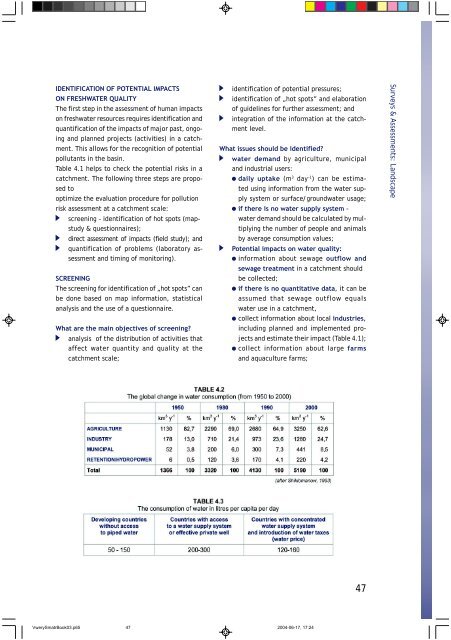Manual - International Environmental Technology Centre
Manual - International Environmental Technology Centre
Manual - International Environmental Technology Centre
You also want an ePaper? Increase the reach of your titles
YUMPU automatically turns print PDFs into web optimized ePapers that Google loves.
IDENTIFICATION OF POTENTIAL IMPACTS<br />
ON FRESHWATER QUALITY<br />
The first step in the assessment of human impacts<br />
on freshwater resources requires identification and<br />
quantification of the impacts of major past, ongoing<br />
and planned projects (activities) in a catchment.<br />
This allows for the recognition of potential<br />
pollutants in the basin.<br />
Table 4.1 helps to check the potential risks in a<br />
catchment. The following three steps are proposed<br />
to<br />
optimize the evaluation procedure for pollution<br />
risk assessment at a catchment scale:<br />
screening – identification of hot spots (mapstudy<br />
& questionnaires);<br />
direct assessment of impacts (field study); and<br />
quantification of problems (laboratory assessment<br />
and timing of monitoring).<br />
SCREENING<br />
The screening for identification of „hot spots” can<br />
be done based on map information, statistical<br />
analysis and the use of a questionnaire.<br />
What are the main objectives of screening?<br />
analysis of the distribution of activities that<br />
affect water quantity and quality at the<br />
catchment scale;<br />
identification of potential pressures;<br />
identification of „hot spots” and elaboration<br />
of guidelines for further assessment; and<br />
integration of the information at the catchment<br />
level.<br />
What issues should be identified?<br />
water demand by agriculture, municipal<br />
and industrial users:<br />
daily uptake (m3 day-1 ) can be estimated<br />
using information from the water supply<br />
system or surface/groundwater usage;<br />
if there is no water supply system -<br />
water demand should be calculated by multiplying<br />
the number of people and animals<br />
by average consumption values;<br />
Potential impacts on water quality:<br />
information about sewage outflow and<br />
sewage treatment in a catchment should<br />
be collected;<br />
if there is no quantitative data, it can be<br />
assumed that sewage outflow equals<br />
water use in a catchment,<br />
collect information about local industries,<br />
including planned and implemented projects<br />
and estimate their impact (Table 4.1);<br />
collect information about large farms<br />
and aquaculture farms;<br />
VwerySmatrBook03.p65 47<br />
2004-06-17, 17:24<br />
47<br />
Surveys & Assessments: Landscape

















